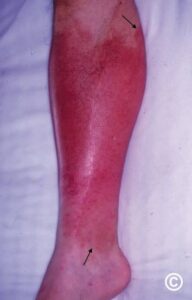Back to: MICROBIOLOGY 300 LEVEL
Welcome to class!
It’s wonderful to have you here again. Today, we’re going to talk about three common but serious skin infections—Boils, Cellulitis, and Necrotising Fasciitis. These are not just things you hear about in hospitals—they affect real people in real communities, from city centres in Abuja to rural clinics in Cross River. Understanding them helps you identify warning signs early, support treatment, and prevent complications.
Boils, Cellulitis, Necrotizing Fasciitis
Understanding Skin Infections
Your skin is the body’s first defence, like a strong fence around a house. But when there’s a cut, scratch, insect bite or break in the skin, bacteria can sneak in and cause infections. Depending on how deep and fast the bacteria spread, the infection can be mild or life-threatening.

Let’s look at these three conditions one by one:
Boils (Furuncles)
A boil is a painful, red lump that forms under the skin when bacteria infect and inflame a hair follicle or oil gland.
Common Cause:
Staphylococcus aureus—often from unwashed hands, dirty clippers, or sharing personal items.
Where it Happens:
Usually on the face, neck, armpits, buttocks or thighs.
Symptoms:
Swollen, red, tender lump filled with pus. It may burst and drain on its own or require medical attention.
Everyday Example:
Think of someone who visits a barbing salon and gets a small nick. If the clippers weren’t disinfected, bacteria can enter and form a boil within a few days.
Cellulitis
This is a deeper skin infection that spreads to the fat and soft tissues beneath the surface.
Common Cause:
Usually Streptococcus pyogenes or Staphylococcus aureus.
Where it Happens:
Anywhere, but often on the legs, arms, or face—especially where there’s a wound or skin crack.
Symptoms:
Red, swollen, warm skin that may be painful and tender. Fever and chills can also occur.
Why It Matters:
If untreated, cellulitis can spread into the bloodstream and become dangerous. Diabetic patients and elderly people are especially at risk.
Necrotising Fasciitis
This is a rare but deadly infection that spreads rapidly through the fascia—the tissue covering muscles and organs. People call it “flesh-eating disease,” although the bacteria don’t literally eat flesh—they release toxins that destroy tissue.
Common Cause:
Streptococcus pyogenes is the main culprit, but others like Clostridium can be involved.

Where it Happens:
Usually after surgery, injury, or in people with weak immune systems.
Symptoms:
Sudden severe pain in an area that may not look very infected at first. The skin may turn dark, and blisters or dead tissue may appear. Fever, vomiting, and confusion often follow.
Emergency Situation:
This is a medical emergency. It needs urgent surgery and strong antibiotics.
Summary
- Boils are localised skin infections caused by bacteria entering through hair follicles.
- Cellulitis is a deeper, spreading skin infection with redness, swelling, and pain.
- Necrotising fasciitis is a fast-moving, tissue-destroying infection requiring urgent medical care.
- All three are linked to bacteria commonly found on the skin and can be worsened by poor hygiene or delayed treatment.
Evaluation
- What is the main difference between a boil and cellulitis?
- Which bacteria is commonly involved in necrotising fasciitis?
- Mention two ways to prevent skin infections in daily life.
Every lesson you take brings you closer to saving lives, serving your community, and becoming a confident microbiologist. Keep growing, and remember—Afrilearn is always here to help you understand, succeed, and shine. See you in the next class!
